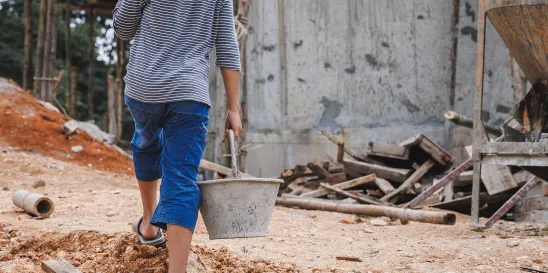The United States Customs and Border Protection (CBP) prioritizes enforcing rules against the use of forced labor and human trafficking.[1] The CBP’s ramped-up enforcement of the Uyghur Forced Labor Prevention Act (UFLPA) is evidence. The UFLPA presumes that goods linked (geographically and in other ways) to the Xinjiang Uyghur Autonomous Region (XUAR) are the product of forced labor. A massive increase in the quantity of detained goods has resulted from the CPB’s focused UFLPA enforcement efforts. To date, thousands of shipments have been detained by the CBP for an investigation into the use of forced labor in their production.
The CBP uses the indicators of forced labor developed by the International Labor Organization (ILO) to identify and prevent the importation of goods produced using forced labor. The CBP believes the ILO indicators “represent the most common signs that point to the possible existence of a forced labor case.”[2] Manufacturers should become familiar with these indicators and how they are used by the CBP to minimize the risk that their component parts or products will be held or seized by the CBP.
But before discussing the ILO indicators and how manufacturers can leverage them to ensure their supply chains are free from goods produced and manufactured using forced labor, it’s necessary to understand why the CBP relies on indicators of forced labor in the first instance.
Why Indicators of Forced Labor Are Important
For venerable reasons of public policy, United States law bars the importation of goods made using forced labor.[3] The CBP is the agency responsible for enforcing federal law and preventing products from entering the market. The CBP is charged with “investigating and acting upon allegations of forced labor in supply chains.”[4] When the CBP has “reasonabl[e], but not conclusive” information that forced labor was used to manufacture or produce particular goods entering the United States, the CBP issues a Withhold Release Order (WRO). A WRO detains the suspect goods pending further investigation.[5] If the CBP subsequently determines it has conclusive evidence that forced labor was used to produce or manufacture a product, it can issue a “Finding.” Once issued, a Finding allows the CBP to seize the offending product at all ports of entry into the United States[6] Once goods are detained or seized, importers must either re-export the detained shipments or demonstrate that the goods are not tainted by forced labor.[7]
The CBP is currently enforcing 51 active WROs and 8 Findings.[8] Though forced labor can be found anywhere, and in any industry, geography seems to be the most significant risk factor: 41 of the 51 active WROs pertain to goods produced in Asia, 35 of which involve China.
In addition, the UFLPA creates a rebuttable presumption that all goods mined, produced, or manufactured in XUAR (whether in whole or in part) or by an entity on the UFLPA’s Entity List[9] are tainted by forced labor and are thus automatically prohibited from importation into the United States. Thus, in addition to the thousands of blocked entries under the original forced labor rules, the CBP detained over 5500 shipments, worth nearly $2 billion, over concerns about potential violations of the UFLPA.[10]
Against this backdrop, how does the CBP determine whether goods are manufactured or produced using forced labor? Congress defines forced labor as “all work or service which is exacted from any person under the menace of any penalty for its nonperformance and for which the worker does not offer himself voluntarily.”[11] This definition, though a helpful starting point, offers little practical guidance on how investigators might identify forced labor. That’s where the ILO’s indicators of forced labor come into play. They offer specific, real-world guidance about indicators of forced labor around the world.
What are the Indicators of Forced Labor?
When issuing WROs, the CBP frequently cites particular ILO indicators of forced labor. The ILO is a specialized U.N. agency responsible for creating international labor standards and helping countries implement these policies domestically. The ILO developed the indicators to help enforcement agencies “identify persons who are possibly trapped in a forced labor situation, and who may require urgent assistance.”[12] The eleven indicators are:[13]
- Abuse of vulnerability
- Deception
- Restriction of Movement
- Isolation
- Physical and sexual violence
- Intimidation and threats
- Retention of identity documents
- Withholding of wages
- Debt bondage
- Abusive working and living conditions
- Excessive overtime
The ILO also offers practical guidance on how these indicators manifest. Some of the indicators may be relatively easy to identify with due diligence or an investigation. For example, “abuse of vulnerability” may be detected when laborers “lack knowledge of local language or laws, have few livelihood options, belong to a minority religious or ethnic group, [or] have other characteristics that set them apart from the majority population.”[14] And the risk for “abuse of vulnerability” is heightened in cases of “multiple dependency”—i.e., when employees depend on the employer “not only for his or her job but also for housing, food[,] and for work for his or her relatives.”[15] “Restriction of movement” can be evidenced by employees’ limited ability to move by surveilling or accompanying employees both inside and outside the workplace.[16] “Isolation” may be shown if, for example, goods are made in a remote worksite with limited or no means of transportation for employees, confiscation of phones or other means of communication, and unregistered or informal business premises.[17] And, “abusive working and living conditions” may be identified by inspecting the work and housing facilities.
But other indicators, such as “deception,” “physical and sexual violence,” “intimidation and threats,” “retention of identity documents,” “withholding of wages,” “debt bondage,” and “excessive overtime,” may only be revealed through a more thorough on-site investigation, inquiry into the producer’s policies (formal and informal), and employee interviews.
Though not formally adopted in the federal code or regulations, these ILO indicators are crucial because the CBP believes that the ILO indicators “represent the most common signs that point to the possible existence of a forced labor case.”[18] The CBP routinely relies on these indicators when determining whether to issue WROs. For example, in November 2022, the CBP issued a WRO for all raw sugar and sugar-based products produced in the Dominican Republic by Central Romana Corporation Limited.[19] In that WRO, the CBP cited five of the ILO indicators—abuse of vulnerability, isolation, withholding wages, abusive working conditions, and excessive overtime—as support the conclusion that forced labor may be occurring.[20] Similarly, the CBP removed a WRO from shipments from Natchi Apparel Ltd., an India-based company, only after the corporation satisfactorily addressed all five of the ILO indicators of forced labor identified in the WRO.[21] These are just two of the many examples.[22]
How Can Manufacturers Leverage the Indicators to Eradicate Forced Labor from Their Supply Chains?
Importers bear the burden to protect their goods from exclusion or seizure at a port of entry.[23] The CBP recommends importers develop a “social compliance system” to combat forced labor.[24] Manufacturers can implement this system by completing two categories of actions: (1) mitigating the risk by engaging stakeholders and partners, assessing risks and impacts, communicating and training the supply chain, and developing a code of conduct; and (2) monitoring the compliance, remediating violations, conducting independent reviews, and reporting performance and engagement.[25] Incorporating the indicators and their manifestations into both mitigation and compliance due diligence and investigations may help manufacturers identify and address human rights compliance weaknesses in their supply chains.
Importers should also monitor the CBP website for updates on foreign entities subjected to WROs or Findings and ensure their own supply chains are not receiving materials from those entities.[26] To stay up to date on key policies, manufacturers should consider attending CBP’s trade outreach webinars (available live and pre-recorded) that provide updated information on trade policy organized for a variety of industries.[27] Manufacturers should also look into the Bureau of International Labor Affairs’ “Comply Chain”—a series of business tools that the U.S. Government provides to businesses to help mitigate risks of forced labor in their supply chains.[28]
Similarly, companies should keep an eye on the work of universities and non-government organizations (NGOs) focused on forced labor and human trafficking.[29] NGOs routinely issue important reports highlighting issues related to forced labor in supply chains that may foreshadow increased governmental enforcement. Some reports name names and even list companies suspected of employing forced labor.[30]
In addition, manufacturers should be aware that the CBP’s dramatically ramped-up enforcement of the UFLPA, resulted in thousands of additional detentions of goods (only half of which were ultimately cleared for entry into the United States). The CBP and other federal agencies also release multiple compliance tools to help companies proactively scrutinize their supply chains and deal with potential admissibility reviews. These resources include the “Xinjiang Supply Chain Business Advisory,”[31] the “Addendum to the Xinjiang Supply Chain Business Advisory,”[32] and the CBP “Uyghur Forced Labor Prevention Act: U.S. Customs and Border Protection Operational Guidance for Importers.”[33]
A good starting point for any manufacturing company is to use these online tools in conjunction with a forced labor and supply chain risk assessment, as we outline here. But, to ensure that compliance and investigations are sufficiently comprehensive, companies should be sure to consult with attorneys to ensure supply chains comply with CBP regulations.
[1] See, e.g., U.S. Customs and Border Protection, CBP Takes Aim at Forced Labor (Sep. 30, 2022), available at https://www.cbp.gov/frontline/cbp-takes-aim-forced-labor; U.S. Customs and Border Protection, Border Patrol Infiltrates Elaborate Human Smuggling Scheme (last modified Aug. 3, 2023), available at https://www.cbp.gov/newsroom/local-media-release/border-patrol-infiltrates-elaborate-human-smuggling-scheme.
[2] U.S. Customs and Border Protection, Forced Labor (last modified May 25, 2023), available at https://www.cbp.gov/trade/forced-labor.
[3] Id.
[4] U.S. Customs and Border Protection, Forced Labor (last modified May 25, 2023), available at https://www.cbp.gov/trade/forced-labor.
[5] 19 C.F.R. 12.42(e); U.S. Customs and Border Protection, Withhold Release Orders and Findings List (last modified May 17, 2023), available at https://www.cbp.gov/trade/forced-labor/withhold-release-orders-and-findings.
[6] U.S. Customs and Border Protection, Withhold Release Orders and Findings List (last modified May 17, 2023), available at https://www.cbp.gov/trade/forced-labor/withhold-release-orders-and-findings.
[7] U.S. Customs and Border Protection, Forced Labor Frequently Asked Questions (last modified May 16, 2023), available at https://www.cbp.gov/trade/programs-administration/forced-labor/frequently-asked-questions.
[8] Id.
[9] See U.S. Customs and Border Protection, Uyghur Forced Labor Prevention Act (last modified July 21, 2023), available athttps://www.cbp.gov/trade/forced-labor/UFLPA.
[10] See U.S. Customs and Border Protection, Uyghur Forced Labor Prevention Act Statistics (last modified Oct. 21, 2023), available at https://www.cbp.gov/newsroom/stats/trade/uyghur-forced-labor-prevention-act-statistics.
[11] 19 U.S.C. § 1307.
[12] International Labour Office, ILO Indicators of Forced Labour at 2 (October 1, 2012), available at https://www.ilo.org/wcmsp5/groups/public/—ed_norm/—declaration/documents/publication/wcms_203832.pdf.
[13] Id.
[14] Id. at 5.
[15] Id.
[16] Id. at 9.
[17] Id. at 11.
[18] U.S. Customs and Border Protection, Forced Labor (last modified May 25, 2023), available at https://www.cbp.gov/trade/forced-labor.
[19] U.S. Customs and Border Protection, CBP Issues Withhold Release Order on Central Romana Corporation Limited (November 23, 2022), available at https://www.cbp.gov/newsroom/national-media-release/cbp-issues-withhold-release-order-central-romana-corporation.
[20] Id.
[21] U.S. Customs and Border Enforcement, CBP Modifies Withhold Release Order on Natchi Apparel (P) Ltd. (September 9, 2022), available at https://www.cbp.gov/newsroom/national-media-release/cbp-modifies-withhold-release-order-natchi-apparel-p-ltd.
[22] U.S. Customs and Border Protection, Withhold Release Orders and Findings List (last modified October 10, 2023), available at https://www.cbp.gov/trade/forced-labor/withhold-release-orders-and-findings.
[23] U.S. Customs and Border Protection, Forced Labor (last modified May 25, 2023), available at https://www.cbp.gov/trade/forced-labor
[24] U.S. Customs and Border Protection, What can importers do to help combat forced labor? (last modified October 12, 2021), available at https://www.cbp.gov/document/fact-sheets/what-can-importers-do-help-combat-forced-labor.
[25] Id.
[26] U.S. Customs and Border Protection, Forced Labor Frequently Asked Questions (last modified May 16, 2023), available at https://www.cbp.gov/trade/programs-administration/forced-labor/frequently-asked-questions.
[27] U.S. Customs and Border Patrol, Trade Outreach Webinars (last modified June 9, 2023), available at https://www.cbp.gov/trade/stakeholder-engagement/webinars.
[28] U.S. Dept’ of Labor, Comply Chain: Business Tools for Labor Compliance in Global Supply Chains (last accessed Nov. 10, 2023), available athttps://www.dol.gov/general/apps/ilab-comply-chain.
[29] United Nations, Resources: The United Nations Voluntary Trust Fund on Contemporary Forms of Slavery (last accessed Nov. 10, 2023) (listing NGOs and other organizations that do work related to forced labor and human trafficking), available at https://www.ohchr.org/en/about-us/ohchrs-funding-and-budget/trust-funds/united-nations-voluntary-trust-fund-contemporary-forms-slavery/resources.
[30] See, e.g., Laura Murphy, et al., Driving Force: Automotive Supply Chains and Forced Labor in the Uyghur Region (Dec. 2022), available at https://www.shu.ac.uk/helena-kennedy-centre-international-justice/research-and-projects/all-projects/driving-force.
[31] U.S. Dep’t of State, Dep’t of Treasury, Dep’t of Commerce, and Dep’t of Homeland Security, Xinjiang Supply Chain Business Advisory (issued July 1, 2020), https://www.bis.doc.gov/index.php/documents/pdfs/2569-xinjiang-supply-chain-business-advisory-final-for-508/file.
[32] U.S. Dep’t of State, Dep’t of Treasury, Dep’t of Commerce, and Dep’t of Homeland Security, Addendum to the Xinjiang Supply Chain Business Advisory (last accessed Nov. 10, 2023), https://www.state.gov/xinjiang-supply-chain-business-advisory/.
[33] U.S. Customs and Border Patrol, Uhyghur Forced Labor Prevention Act: U.S. Customs and Border Protection Operational Guidance for Importers (June 13, 2022), https://www.cbp.gov/sites/default/files/assets/documents/2022-Jun/CBP_Guidance_for_Importers_for_UFLPA_13_June_2022.pdf.






 />i
/>i

